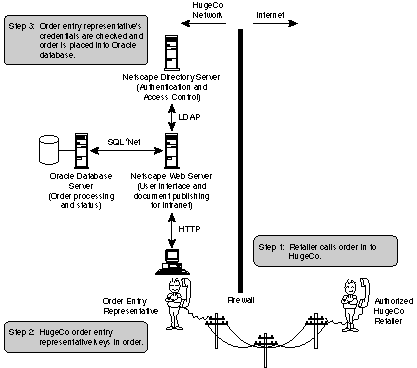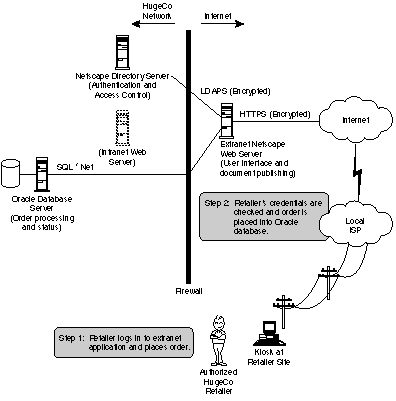Determining and Prioritizing Application Needs
| Understanding and Deploying LDAP Directory Services > 26. Case Study: An Enterprise with an Extranet > An Overview of the Organization |
An Overview of the OrganizationHugeCo is a supplier of a wide range of custom-built home renovation products, from cabinetry and replacement windows to completely prefabricated homes . Its Home Renovation Products (HRP) division produces cabinets , counters, windows , and other products built to customer specifications and shipped to local home improvement retailers and contractors in the United States and Canada. Instead of maintaining a direct sales force, HugeCo partners with home improvement retailers and contractors who become certified retailers of HugeCo products. Certified retailers place orders for custom-built items, which are manufactured at HugeCo's main factory and shipped to the retailer or directly to the customer site. Retailers can become certified on any of a number of different product lines ”and may sell only those products for which they are authorized. HugeCo currently has about 800 authorized retailers in the United States and Canada. To support each of these retailers, updated product literature and price lists are shipped to each retailer monthly. Because the ordering process is quite complex and varies from product to product, the literature includes worksheets that describe the options available for each product and any measurements, which must be supplied before the manufacturing process can begin. HugeCo, an early adopter of database technology, uses a large Oracle installation to track the progress of orders through the system, from initial order to final shipment. Although the order tracking system had provided large gains in productivity at lower cost compared to the older system, its user interface was somewhat lacking. With the advent of World Wide Web technology, HugeCo's IS staff developed a Web-based interface for the system, making it easier to use, and therefore, lowering training costs. Spurred on by the initial success of the order management system, HugeCo staff established an email link between the manufacturing staff and the sales staff. The craftsperson responsible for building a custom set of cabinets, for example, can send electronic mail to the sales representative who originally took the order to request clarification on some aspect of the work order. Recently, HugeCo management started a new project ”a corporate extranet that aimed to extend the benefits of HugeCo's intranet to its authorized retailers. The primary motivators behind this extranet deployment were to improve service to retailers and customers and to lower costs. This case study describes the planning and execution of the directory component of this project. The way that authorized retailers used to place orders and learn about status was inefficient and error-prone : All interactions were performed via telephone. The original order was called into a data entry operator, who keyed the information into the order entry application. This transcription step was a source of errors. And if a retailer needed to check on the status of an existing order, a call had to be placed to the central office during business hours. This order management system architecture is shown in Figure 26.1. Figure 26.1 The old order entry system architecture. As shown in Figure 26.1, the Web server provides an easy-to-use front end to the order entry and tracking database, which is hosted by an Oracle database server. The directory stores the Oracle login passwords so that they can be made available to the Web server CGI programs that comprise the order entry system. A much more attractive alternative would be to allow employees at authorized retailers to place their own orders directly into the Web-based order system, bypassing the data entry operators and improving accuracy. Such a system would also allow retailers to directly check order status 24 hours per day, seven days per week, resulting in better customer service. Such a system is depicted in Figure 26.2. Figure 26.2 The new order entry system architecture. Note that there is a much closer coupling between the retailer and the craftsperson in this system. Such a system should significantly improve responsiveness to retailer needs and higher customer satisfaction. New product information and ordering procedures were distributed along with regular product literature updates shipped to retailers every eight weeks. Because new product notices were distributed so infrequently, a long time could pass between the time a new product was available and the time that orders for it could be placed. An alternative approach was to publish notices about new products and procedures to the extranet. When a new product is available or a new procedure is released, each retail employee can be informed about this via items on a personalized start page. Information about products that the retailer is authorized to sell can be highlighted, whereas information about products not authorized can be hidden. New product literature and price sheets can be published to the extranet Web server, making the new product immediately available for ordering.
|
Index terms contained in this sectioncase studiesHugeCo 2nd 3rd 4th 5th 6th 7th 8th 9th directories case studies HugeCo 2nd 3rd 4th 5th 6th 7th 8th 9th extranets HugeCo case study 2nd 3rd 4th 5th 6th 7th 8th 9th HugeCo case study 2nd 3rd 4th 5th 6th 7th 8th 9th |
| 2002, O'Reilly & Associates, Inc. |
EAN: 2147483647
Pages: 245